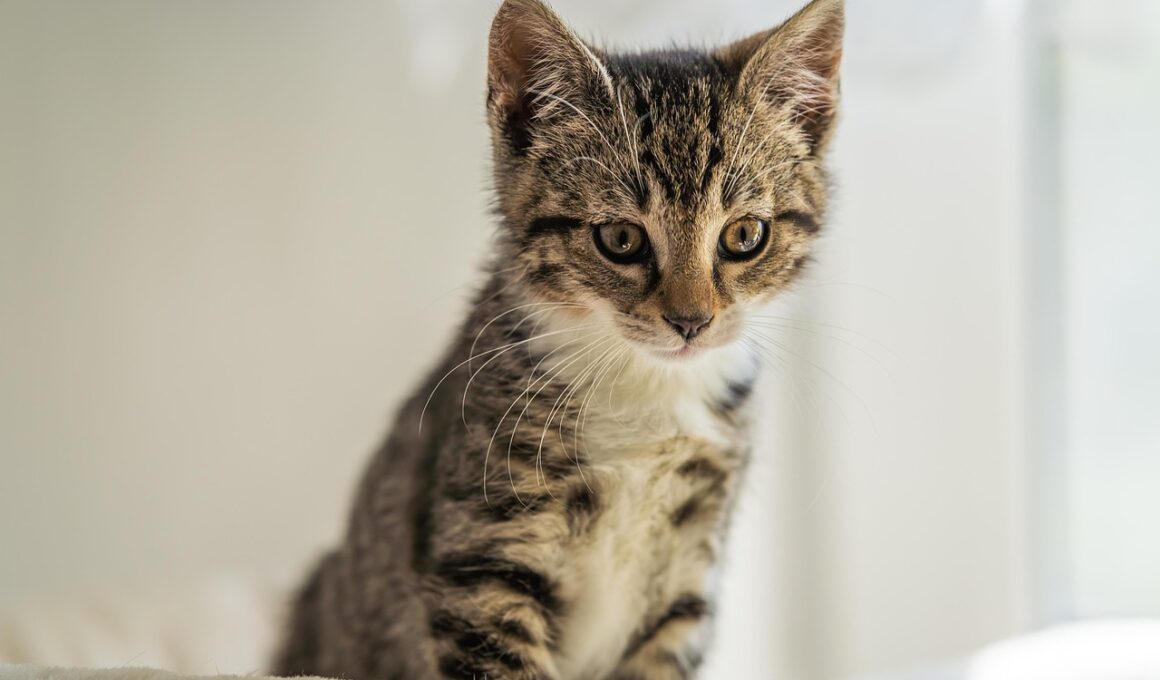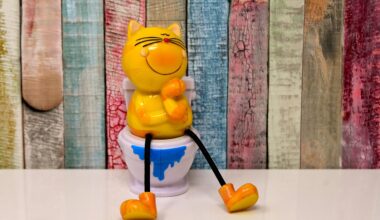Feeding and Hydration Tips for Traveling Kittens
Traveling with kittens can be a delightful yet challenging experience, especially when it comes to their feeding and hydration needs. Keeping your kitten well-fed and hydrated is essential to ensure their comfort and well-being during your journey. First, always pack enough of their regular food in easy-to-carry portions. Familiarity with their diet can help reduce anxiety. Also, consider their dietary restrictions; you may need to consult a veterinarian for travel-friendly options. For hydration, carry a portable water bottle equipped with a cat-friendly bowl. Remember, kittens can easily become dehydrated in warm climates or during long travels. Make sure to offer water regularly, especially during breaks. You can also provide wet food; it is a great way to add extra moisture. Plan your travel schedule to incorporate regular feeding and bathroom breaks. Aim to maintain their usual feeding times to keep their digestive system on track. Lastly, travel stress can lead to a lack of appetite; use enticing treats to coax them if necessary. With careful planning, you can ensure that your kitten stays nourished and healthy throughout your travels.
Along with feeding, keeping your kitten hydrated during travel is crucial. Start by assessing their water intake needs based on their age, weight, and activity level. Kittens require more hydration than adult cats, particularly if they are active. Always ensure access to fresh water, either in a spill-proof travel bowl or a portable pet water fountain. Consider investing in a car that integrates a pet culture for comfort and easy access to supplies. If your kitten is not accustomed to drinking from bowls, use a syringe to offer water. This method can be especially useful when traveling in cars, as it keeps the water contained. If possible, let them drink during comfortable rest stops. If your journey lasts more than a few hours, consider offering wet food containing high moisture content. Additionally, avoid giving them milk, as most kittens are lactose intolerant. To set a good example for your kitten, drink water yourself during breaks; this could encourage them too. Keeping them hydrated will reduce stress and promote better health, ensuring a safe and happy travel experience for both of you.
What to Pack for Feeding and Hydration
Before you set out on your journey, it’s essential to prepare a travel kit that caters specifically to your kitten’s feeding and hydration needs. Start by including several portable food containers or zip-lock bags filled with their usual dry or wet food. This ensures that you have easy access during your travels without the hassle of bulky packaging. Don’t forget to pack bowls that are lightweight and spill-proof to minimize mess during feeding time. Stainless steel bowls are great options, as they are durable and easy to clean. Additionally, always include plenty of fresh bottled water to keep your kitten hydrated. Consider a small collapsible bowl or a pet water bottle with an attached bowl for ease of use. If your kitten is used to a specific brand of treats or special diets, add those to your kit as well. You might want to pack some sanitary supplies such as pet wipes and a small towel for easy cleanup. With a well-prepared kit, feeding and hydrating your kitten on the go will become more manageable and stress-free, ensuring your travel experience is enjoyable.
Another important aspect of ensuring proper feeding and hydration during travel is to adjust to the travel environment. If you are traveling by car or plane, ensure that your kitten is comfortable and secure in their carrier during the journey. Secure carriers should allow your kitten to sit, lie down, and turn around easily. Before embarking on the trip, familiarize your kitten with the carrier by allowing them to explore it beforehand. Placing familiar bedding and a few favorite toys inside can create a sense of comfort. When you reach your destination or take breaks, offer food and water as soon as the carrier is opened; kittens are more likely to eat and drink when they feel secure in familiar settings. However, be aware not to force them to eat immediately; let them acclimatize first. For longer trips, schedule brief stops to allow them to stretch, use the litter box, and hydrate comfortably. A calm journey helps create positive associations, leading to better behavior for future travels. With these adjustments, your kitten will adapt and thrive during your adventures.
Understanding Your Kitten’s Needs
It’s vital to understand your kitten’s unique feeding and hydration needs during travel to ensure their health and happiness. Young kittens require more frequent meals compared to adult cats, as their small stomachs need constant nourishment. As a guideline, consider feeding your kitten at least 3-4 small meals within a day. Feeding becomes more challenging on the road, so sticking to routine as closely as possible will help. Hydration is equally crucial; observe if your kitten is drinking enough water. If they refuse, turn to food alternatives that contain water or broths. Additionally, be attentive to their behavior during travel—if they seem lethargic or refuse food and water, it could signify stress or dehydration. Use a calm voice and offer encouragement; keeping a cheerful expression can help put them at ease. Being patient and observant during your trip will aid in recognizing when your kitten needs a break or extra care. Monitoring their needs ensures they stay satisfied and healthy, so plan ahead to provide tailored care for a successful travel experience.
To enhance your kitten’s travel experience, try incorporating some of their favorite toys or familiar items into their carrier. Familiarity can significantly reduce anxiety, making them feel safe and less likely to stress. Consider purchasing collapsible toys or small toys that easily fit into your travel kit, ensuring entertainment and distraction during breaks. You can also bring along a comforting blanket or piece of cloth that has your scent on it to provide security. Enriching the environment they are in helps maintain their well-being. If your kitten has a favorite treat, utilize it as an incentive to eat or drink—this method can sometimes coax a hesitant traveler into enjoying their food, especially in new situations. If you encounter any issues related to refusing food or water, consult with your veterinarian prior to the trip for tailored solutions or recommendations. Remember, happy kittens equal happy travelers! Adjust your plans according to their needs, and be ready for unexpected moments during the journey. Good preparation can make the difference between a stressful trip and a joyful adventure.
Travel Safety Tips for Kittens
In terms of ensuring successful travel, safety is paramount. As you prepare to travel with your kitten, always keep them secure in a carrier designed for travel. Ensure the carrier meets airline regulations if you are flying. Choose one that allows for adequate airflow and is spacious enough for their comfort. During car rides, secure the carrier with a seatbelt to avoid sudden shifts should you need to stop. Avoid letting your kitten roam freely in the car, as this increases the risk of injury and distraction. Ensure that the environment remains calm by avoiding loud noises and sudden movements while on the road. Frequent stops for bathroom breaks and stretching are crucial; this allows your kitten to acclimate and avoid discomfort. Always keep an ID collar and microchip on your kitten in case they get lost. Additionally, carry a recent photo of them for identification purposes. Keeping these safety measures in mind ensures not just a pleasant experience, but also safeguards your furry friend every step of the way.
In conclusion, traveling with kittens can be enjoyable when you prioritize their feeding and hydration needs. Awareness and preparation are vital for a successful trip. With careful planning and consideration for their specific needs, you’ll ensure their journey is comfortable. Consider their dietary and hydration requirements, and be attentive to their behavior throughout the travel experience. Familiar items can offer comfort, while proper feeding and hydration keep stress levels manageable. Ensure their safety by choosing the right travel gear, such as secure carriers and safety measures in the vehicle. Always consult your veterinarian for tailored advice regarding travel plans, helps to identify what works best for your kitten ahead of time. Remember, a well-fed and hydrated kitten is one that can enjoy travel adventures to the fullest. Maintaining a routine as much as possible keeps your kitten calm. If challenges arise, approach each situation with patience and care. With these essential tips in mind, both you and your kitten can look forward to exploring new environments together, making unforgettable memories that enhance your bond.


